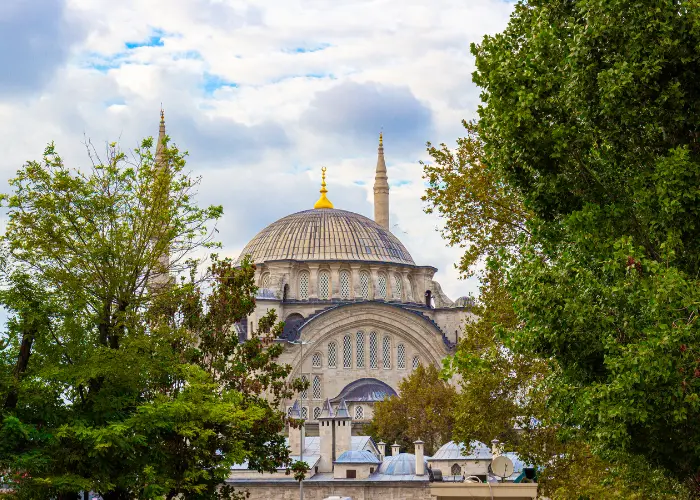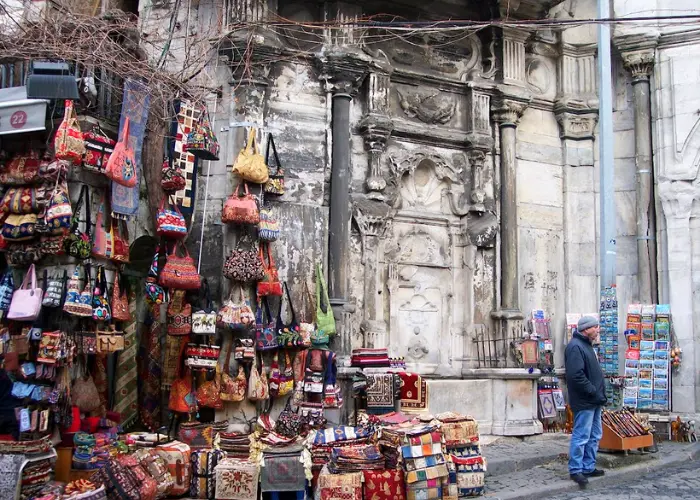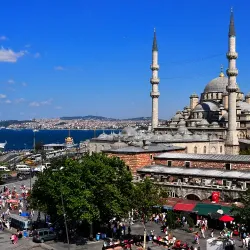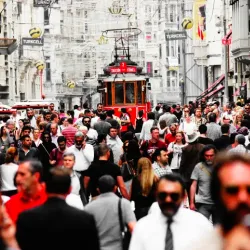This historic city also houses important architectural monuments of the past in its different districts. So much so that even foreign statesmen, poets, writers, and musicians were attracted to the splendor of this city and often mentioned its name. Istanbul has been an important administrative and cultural center for many empires for long years and carries this over to this day. Many districts of the city, which have been established since the Republican period, still stand, preserving their historical structures. Many churches, passages, Orient bazaars, and mosques in Istanbul date back to the Roman, Byzantine, and Ottoman Empire periods. It is possible to encounter these historical traces in important historical districts of the city, such as Besiktas, Ortakoy, Kadıköy, and Fatih. Nuru Osmaniye Avenue is one of the important shopping streets in Istanbul which was known as the 'Orient Bazaar' among locals and tourists.
Nuru Osmaniye and its History

Nur-i Osmaniye is a neighborhood in the district of Fatih, located on the European side of Istanbul. If you follow the slope extending in the northern direction from Çemberlitaş, you can reach Nur-i Osmaniye Street, the district’s main street. This district takes its name from the Nur-i Osmaniye Mosque, located in the same area. As a result of the restoration and renovation works carried out in the mosque and its immediate surroundings, the district has changed dramatically over time. The Main Street of Nur-i Osmaniye was closed to traffic and renovated as a city square.
The Nur-i Osmaniye Mosque has determined the district’s name and has also come down to the present day as an important historical monument. This mosque is the first baroque mosque built in Istanbul, and its construction started in 1748. The mosque and its complex, which appeared when Westernization trends began to appear in architecture, is considered a landmark in Ottoman architecture. A complex consisting of a madrasa, an imaret, a library, a mausoleum, and a fountain was built together with the mosque. We recommend checking out the mosque, various shopping streets, and food and beverage venues while visiting the district.
Nur-i Osmaniye, along with the Grand Bazaar, is one of the busiest places in Istanbul for the gold and precious stones trade. Therefore, this location is home to important shopping streets and Orient bazaars for shopping enthusiasts. The shops and cafes on Nur-i Osmaniye street are quiet and are built to satisfy their guests.
Nur-i Osmaniye, which has historically been one of the important districts of Istanbul, has features that will attract the attention of everyone, both local and foreign. One of these features is that you will feel peaceful in the calm air of the district. When you have finished visiting this district, you can complete the nice trip with a walk at the seaside and return home happy.
What to Buy?
Nuru Osmaniye is known as an Orient bazaar, and it is possible to find many cultural second-hand items there. The shopping streets of Nur-i Osmaniye are home to shops in the Orient bazaar characteristics that reflect the district’s historical features. For example, suppose you are interested in cultural household goods. In that case, you can shop at the stores that make handmade carpets and rugs specific to Turkish culture and communicate with friendly artisans. Another Orient bazaar that you can see when you stroll through the shopping streets of Nur-i Osmaniye will be the shops selling antique goods and clothes. For example, the Sofa Art & Antiques store, located on Nur-i Osmaniye street, close to the Covered Bazaar, offers visitors works of art and antiques from ancient times.

There are many places where you will be fascinated while walking around the shopping streets and historical roads of this district, and you will want to buy gifts for your loved ones. Nuru Osmaniye, known for its Orient Bazaar points, provides a peaceful environment with a different atmosphere. Another store that you can visit in this environment is a store that sells carpets and rugs known as Punto of Istanbul. In this environment where you can have tea and chat, you will be fascinated by artistic rugs, and you will not return empty-handed.
Restaurants in Nur-i Osmaniye
There are many dining and drinking places in Nur-i Osmaniye, decorated with different cultural elements and have a warm atmosphere. You can try delicious Turkish dishes in these places and try Turkish coffee and hookah options. Dehliz Restaurant is located on Nur-i Osmaniye street, which will fascinate you with its cultural decoration and warm atmosphere. You can taste the most delicious and popular dishes of Turkish cuisine here, and you can leave the place satisfied with the service you have received. With its excellent location, reasonable prices, and delicious food, you should visit this neighborhood when you come to it.
The historical Subaşı Restaurant is located near Nur-i Osmaniye street and is the locals’ favorite place. We suggest you try traditional Turkish cuisine dishes in this place because you will like them very much. It is very easy to find Turkish home cooking cooked in one pot, as well as a variety of kebab and meat dishes and a dish that suits your taste buds in this place
Frequently Asked Question
Who built the Laleli mosque?
Laleli Mosque was built by Mehmed Tahir Aga.
When was Nuru Osmaniye mosque built?
Nuru Osmaniye Mosque was built in 1748.
In which district is Nur-i Osmaniye?
Nuruosmaniye Avenue is on the European side, in the Fatih district.
Who built the Suleymaniye?
Suleymaniye Mosque is built by the famous Architect Sinan.
When was Laleli built?
Laleli was built in 1783.
 English
English  Indonesian
Indonesian  Urdu
Urdu  Taiwanese
Taiwanese  Russian
Russian  Romanian
Romanian  Portuguese
Portuguese  Persian
Persian  Macedonian
Macedonian  Korean
Korean  Japanese
Japanese  Italian
Italian  Indian
Indian  Hungarian
Hungarian  Greek
Greek  German
German  Croatian
Croatian  Chinese
Chinese  Bulgarian
Bulgarian  Arabic
Arabic  French
French  Spanish
Spanish 





